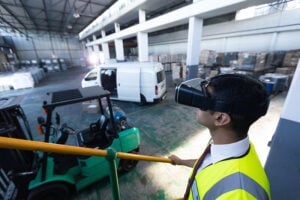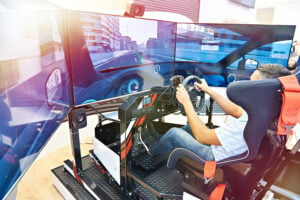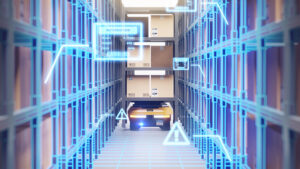There are few working environments that are characterized by such a high level of dynamism as the daily business in a modern logistics center. Only at the usual peak times, such as before Christmas, does such an operation manage to surpass itself in this respect.

In order to take advantage of such dynamics, typical logistics centers resemble a perfectly balanced machine in terms of processes and personnel. But just as with a real machine, the slightest disturbance can have sensitive cascading effects. Even one new employee can represent such a disruption, not to mention major interventions.
Conversely, the highly complex interplay of the various mechanisms at the center can hardly be explained in its entirety to outsiders. There is simply too much going on at the same time to be able to grasp it from a single point of view.
Both are a challenge. After all, this complexity combined with the aforementioned dynamics is definitely prone to errors, as even senior personnel often find it difficult to keep track of everything at the same time. Moreover, for the same reason, it often becomes difficult to integrate personnel gently and carefully into their new workplace during ongoing operations – without disrupting the rest of the processes, but also without leaving the newcomer on his own by “learning by doing”.
Just as digitization can significantly reduce various challenges in other areas of our business, so too can a “playful” version of digital technology in the form of gaming and virtual reality. In the form of so-called gamification, both technologies have what it takes to adequately address typical problem areas and sources of error in a large number of logistics centers – and at the same time provide an increasingly important human resource.
Basic assumption: why the gaming industry is such an excellent role model

Those who are not deeply involved in the subject might assume that there is only one overlap between logistics and gaming: the free-market orientation and the desire to generate the highest possible profits. In fact, this is one overlap – but by no means the only one. In fact, gaming can serve as a role model in several ways.
Let’s start with what is probably the most important point: Gaming remains one of those digital domains that are best suited as “test tubes.” Of all possible digital applications, games and game-like environments make it relatively easy (and inexpensive) to try out new techniques, approaches and the like. Since the first game consoles, which could display little more than two strokes and a moving dot as a tennis racket and ball, the gaming industry has therefore repeatedly become a testing ground for new things before being exploited in other fields.
Further, other points want to be taken into account, through which gaming can shine as a whole:
- This is one of the most important intersections of diverse heterogeneous populations. We have long since reached a point where video games are a largely ageless phenomenon that transcends all social classes. In fact, this business is booming so much that even established analog houses are daring to make the switch – even the well-known “Sands” casino in Las Vegas wants to focus more on the online market in the future, offering B2B solutions for third-party operators in particular. The completely correct basic idea: Gaming has long been too significant in market terms to ignore, and can even enable greater revenues than any conventional approach.
- Modern video games in particular are characterized by enormous complexity, which includes the tasks, thought processes, reactions and corresponding courses of action to be mastered by the player. At the same time, however, the basic elements of games must always be manageable even by absolute novices. This led the developers to an extremely solution-oriented way of thinking. Through it, even complete laymen can learn to master even highly complex games within a very short time – even if there are further learning curves to overcome afterwards in order to keep the game appealing and exciting.
- Video games in general, as well as video game approaches in other areas, have been shown to produce some very positive effects that in turn teach or improve key skills. These include training in sensorimotor skills (such as reaction speed or hand-eye coordination), stress resistance, and problem-solving skills. These learning effects are also independent of the age of the players.
Last but not least, games have another immensely important advantage: they can now create extremely realistic environments (especially in conjunction with virtual reality glasses). Environments that are so realistic that the brain no longer perceives them as “artificial” after a very short time. Flight simulators are probably the best example of this. For many years now, they have been used as the perfect complement to real flying lessons – as they are not only cheaper, but now extremely realistic.
In fact, realism in this field has recently reached a level where developers of “conventional” flight simulators are already openly considering cooperation with flight schools and aviation authorities. Among other things, this is intended to make entry more attractive and less expensive and thus reduce a shortage of personnel that has existed for years.
Moreover, there is another advantage of the gaming industry in this respect: the worlds it creates are extremely transformable. New levels, new environmental conditions, new abilities are feasible for a fraction of the cost and time that would be involved in a real conversion of analog environments. At this point, resourceful people are already realizing the impact this can have on logistics.
The often unrecognized intersection between logistics and gaming

When the really big players in an industry do something, especially if it is something comparatively revolutionary, then common sense dictates that this action be carefully observed and analyzed.
In this regard, various logistics giants have recently distinguished themselves by creating virtual centers. Their goal is to make it possible to experience modern logistics centers in an almost playful way. Of course, such companies do not do this without reason; such gamification actually makes a lot of sense due to the intersections between the gaming and logistics worlds:
- Both are highly complex worlds, which must nevertheless be comprehensible to each individual to a large extent and at a low level.
- Both often involve repetitive tasks, which nevertheless have to be designed in a way that is stimulating for the players or employees so that boredom does not arise.
- Game and work both benefit when participants can really lose themselves in it – positively speaking.
- Both benefit from motivators that appeal to the reward system. However, this is much easier to achieve in games than in logistics.
However, one thing must be stated here for the sake of honesty: As much as these overlaps exist, logistics benefits significantly more from gamification than would be the case the other way around.
Gaming and Virtual Reality in logistics: reasons and implementation possibilities

The companies that create such virtual logistics centers do so primarily in order to be able to virtually experience a (real) site with a maximum level of realism using VR glasses – with training, customer demonstrations and planning as particular beneficiaries.
In fact, this already defines three extremely important core areas. That is, the planning of almost any scenario, the training of people, and an extremely realistic presentation for laypersons as well as for experts. However, strictly speaking, these are only generic terms. In practice, there is a broader field of reasons and implementation possibilities for a more playful, virtual approach to the logistics center of today and tomorrow.
Modern Recruitment: Human Resource Gamer
Video games have been around since the 1970s. By the 1980s, they had already become a defining factor in Western teenagers’ bedrooms – to become completely indispensable in the 1990s. Even among children and young people who were not decidedly digital.
In this regard, a simple fact holds true for 20-something recruiting: a large percentage of everyone of interest as a workforce grew up in a deeply gamified digital environment.
- The Xennials generation, a micro-generation between Generation X and Millennials (birth period between 1977 and 1983),
- Generation Y or Millennials (birth period approx. 1981 to 1996) and
- Generation Z or Zoomers (birth period approx. 1997 to 2010).
All of these people came into contact with video games to a considerable extent since their earliest youth. The younger they are today, the stronger the degree of development and thus realism of these games and thus the generic learning or educational effect.
In addition, HR managers must already prepare for the successors in the form of Generation Alpha (birth cohorts from 2011). This generation will enter the training market in the second half of their 20s.
These people were and are strongly shaped by digital-gaming components during their important childhood and adolescent formative phase. Accordingly, they can often not only find their way around such an environment more easily, but also act more effectively in it than members of generations who were only exposed to video games in young adulthood.
Simplified learning and training without disrupting operations

How do you integrate a newly hired picker in an analogous way, for example? Typically, by placing an experienced picker at his side so that the newcomer gets to know the work processes over a few days.
But what is the inevitable side effect of such an approach? The experienced picker, even if the novice shows rapid learning success, is inevitably inhibited in his effectiveness.
- Tempo,
- Work rhythm,
- Actions that normally do not require much thought
are inevitably delayed with such an “appendage”. This would be the case even if the new employee were also an experienced picker but still internalized the processes at his previous employer – in such a case, the impact would be even more dramatic. After all, it is significantly easier to teach a person completely new topics than to modify existing knowledge.
This is where a virtual logistics environment shines in a special way. Regardless of whether they are absolute newcomers to the profession or employees from other companies and areas: With a VR-based environment, they can learn all relevant activities (any activity in the logistics center, by the way) without needing other personnel to do so or even just the actual work environment.
In fact, it is sufficient to have these people trained in separate premises. If the VR program is designed to be appropriately realistic (i.e., modeled 1:1 on the real object), then the learning effect is the same as if the newcomer were operating between real shelves.
By the way: Existing employees can be familiarized with far-reaching restructuring in the same way. This makes it possible, for example, to quickly restore the usual smoothness after a hall reorganization or a company relocation.
Reward system for repetitive work

Some jobs in the logistics center are not particularly demanding, either physically or mentally (given the right routine). Nevertheless, they can be exceedingly draining because they are so repetitive.
In this regard, Amazon, among others, is demonstrating what is possible thanks to gamification. In its U.S. logistics centers, the e-commerce giant has been using video game components for some time to make work more playful and thus more entertaining. For example, the control interfaces for robots are designed as if they were video game environments. In addition, the programs used can distribute various virtual rewards (such as points) for working quickly and correctly.
However, gamification of this kind is not free of criticism. Critics see it as an attempt to increase productivity without the employees being aware of it. However, the success of this gamification proves them right – Amazon is not the only company to take this approach in logistics centers. In fact, the scope of application is not even limited to logistics; many other companies also act in this way.
Opportunities for digitization below fully autonomous robotics
We live in an age in which robotics has advanced as far in reality as it was only possible in movies in earlier times. Of course, there are already a considerable number of robots that actually operate fully autonomously for use in logistics. This means that these devices work (for example, pick) entirely without human interaction in daily operations.

But as much as autonomous robots are celebrated in the industry, as much as trade magazines praise them again and again and use very large logistics companies as examples for this, one fact can be established: At the beginning of the 2020s, such “real” robots are still extremely expensive on the one hand and therefore nowhere near as widespread as some assume.
Moreover, even Autonomous Mobile Robots (AMR) nevertheless often need a person to give at least certain work instructions. Depending on the exact device, they are even “only” largely remote-controlled robots.
However, this “only” should in no way sound pejorative. After all, it is precisely this type of equipment that offers very good opportunities for integrating robotics into logistics operations via gamification, which for various reasons cannot or do not want to implement a full-scale AMR fleet. In particular, the use of VR glasses enables operators to control these robots as if they were sitting on board themselves – or even doing the picking themselves.
Even if the personnel in this way only humanly control the actual picking process, while the travel paths are completed autonomously, this also allows personnel to be freed up for other tasks, as one employee can control several robots and switch between them.
Process optimization through live overlays
Below virtual reality, there is the concept of augmented reality (AR). Whereas in VR the entire environment is virtual, in AR only a certain virtual portion is superimposed on the image of reality – think of a car windshield onto which digital navigation symbols are reflected.
This is also possible in logistics operations and is perhaps one of the most cost-effective options here. Here, AR usually manifests itself in the form of glasses. For example, they can show employees the digitally calculated shortest route to a product – or display live picking lists that can even be updated during the process.
Last but not least, AR is an extremely useful way to gently introduce older employees who might be unsettled or overwhelmed by entirely virtual environments.
Variable scenarios on the subject of security

What merely exists virtually can be changed dramatically in just a few steps – extremely quickly and exceptionally cost-effectively. Particularly when it comes to security in logistics operations, things can therefore be simulated realistically that could not be done “in real life” due to their dangers. Some examples of this:
- Forklift drivers can use realistic physics models to learn how their industrial truck behaves under extreme driving conditions. For example, when there is a risk of tipping over in curves.
- It could simulate for all employees what the halls would look like in the event of a sudden power failure with only emergency lighting – or full of smoke in the event of a fire.
- Various other hazard scenarios can be shown to train correct behavior. For example, obstacles lying behind a bend, the breakage of a pallet and the like.
Neuroscientists have known for a long time that no oral explanation, no diagram or film can generate such a high learning effect as personal experience. However, when it comes to safety-related behaviors in particular, it is only the virtual reality made possible by gaming engines that is actually able to convey this almost as in reality.
A brief look into the future

Gaming and virtual reality are only just beginning to conquer logistics on a broad scale and comprehensively change the work that takes place there. But in the near to medium term, even the following processes will no longer be dreams of the future if development continues at the same pace:
- Overall, logistics is becoming a particularly attractive workplace for people with a high affinity for games. The industry has great advantages here, as few other fields can implement gamification so well without modifying basic work processes. The personnel shortage could therefore be significantly alleviated – especially since robotics, for example, makes certain tasks less personnel-intensive.
- Overall, work could seem less like work through clever virtualization. This can increase motivation among all employees. It also reduces absenteeism and mood-related underperformance.
- Managers have much more data at their disposal, which makes even the highly complex processes of logistics much more transparent. For example, processes can be identified that previously caused delays or sources of errors without being noticed.
- Delivery vehicles could be controlled from a distance. Even then, one driver would still be needed per vehicle. However, this driver could alternate shifts with colleagues in a control center. This would significantly reduce the shortage of personnel – especially on long-distance routes.
With the further expansion of the 5G network and the future Internet called Metaverse, it would be possible to create even more scenarios that may seem all too futuristic today. For example, a customer could take a product he has ordered from the shelf, pack it and hand it over to a drone – which he could also steer to himself – with the help of a robot controlled by him.
Especially as far as the metaverse is concerned, this would be nothing less than an overwhelming victory for gamification. Because it would give the entire virtual world an enormous playful touch.
Conclusion
Gaming, virtual reality and logistics centers may not have much in common at first glance. In fact, however, the opposite is true. Between reduced training time, better performance monitoring, and reduced risks for accidents and mishandling, it’s a synergistic effect whose value is hard to quantify. Logistics has many years of growth ahead of it. Downright game-changing digital techniques are the most effective and, as it were, the most favorable long-term means of overcoming all the challenges that this entails.









